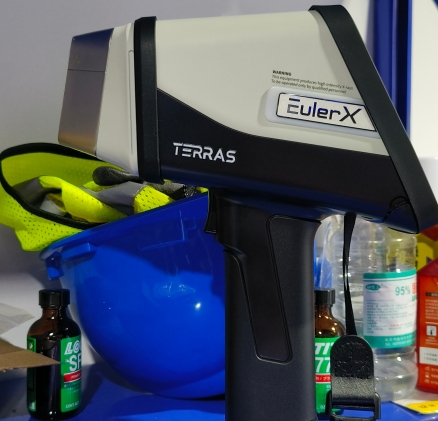
Positive Material Identification
A high-tech enterprise focusing on the development and application of X-ray technology products, committed to becoming a leading supplier of X-ray industrial testing solutions.
A Beginner’s Guide to PMI XRF Analyzers: What You Need to Know
1.1 What is a PMI XRF Analyzer?
A PMI XRF analyzer is a portable device used for material analysis, primarily for determining the elemental composition of metals and alloys. PMI stands for "Positive Material Identification," while XRF stands for "X-ray Fluorescence." The XRF technology detects elements in a sample by emitting X-rays.
1.2 Main Functions
Material Identification: Quickly and accurately identifies different materials.
Alloy Analysis: Particularly suited for analyzing complex alloys.
Field Testing: Provides portability, allowing for on-site analysis.
Working Principle

Terras EulerX900 Handheld Alloy Analyzer
2.1 X-ray Emission
The analyzer emits high-energy X-rays onto the sample surface. When the X-rays interact with the atoms in the sample, they excite the atoms.
2.2 Fluorescent X-ray Emission
The excited atoms emit fluorescent X-rays with specific energy levels. These fluorescent X-rays have characteristic wavelengths and energies that can be used to identify the elements present in the sample.
2.3 Data Analysis
The fluorescent X-rays are captured by a detector and processed by the analyzer’s internal software. Based on the energy and intensity of the fluorescent X-rays, the software determines the concentration of each element in the sample.
Device Features
3.1 Portability
Many PMI XRF analyzers are designed to be portable, featuring handles and lightweight construction for easy use in the field. Portability is crucial for on-site testing at construction sites, warehouses, or production lines.
3.2 Analysis Speed
Modern PMI XRF analyzers can provide results in just a few seconds, significantly improving work efficiency. The devices often have automatic calibration features, reducing the need for manual intervention.
3.3 Analysis Accuracy
The accuracy of the analyzer depends on its design and calibration. High-quality devices can provide very precise elemental analysis results, typically within a range of 0.1% to 1%.
3.4 User Interface
Many analyzers come with user-friendly touch screen interfaces and intuitive software, making operation straightforward and accessible even for users without a technical background.
Applications
4.1 Manufacturing
In manufacturing, PMI XRF analyzers are used to ensure that raw materials and products meet specifications. They help detect material compliance and prevent the use of substandard materials.
4.2 Recycling Industry
In the recycling industry, analyzers assist in identifying the composition of various waste materials, ensuring proper sorting and processing during recycling.
4.3 Construction and Engineering
In construction and engineering projects, PMI XRF analyzers are used to verify the composition of structural materials, ensuring that the project meets safety and quality standards.
4.4 Regulatory Compliance
Many industries require compliance with specific regulations, and PMI XRF analyzers can help businesses ensure their materials and products meet relevant regulatory requirements.
Maintenance and Calibration
5.1 Daily Maintenance
Cleaning: Regularly clean the device’s exterior and detector to prevent dust and dirt from affecting performance.
Inspection: Frequently check the device’s battery and connection cables to ensure proper functioning.
5.2 Calibration
Regular Calibration: Perform regular calibrations as recommended by the manufacturer to maintain accuracy.
Standard Samples: Use known composition standard samples for calibration to ensure precise analytical results.
Advantages and Limitations
6.1 Advantages
Rapid Analysis: Provides immediate material composition results, reducing testing time.
Portable: Suitable for on-site testing, increasing flexibility in work.
Non-destructive Testing: Does not damage the sample, making it ideal for valuable or limited samples.

Terras EulerX900 Handheld Alloy Analyzer
6.2 Limitations
Element Range: May not detect all elements, especially light elements (such as hydrogen, helium).
Sample Preparation: Although suitable for field use, some samples may require pre-treatment.
Cost: High-quality PMI XRF analyzers can be expensive, which may not be feasible for budget-constrained small businesses.
The EulerX 990 is a cutting-edge handheld gold analyzer equipped with a ceramic packaged microfocus X-ray tube and a high-performance semiconductor detector. Utilizing advanced software algorithms, it can perform quick, accurate, and non-destructive testing of gold, silver, platinum, and other precious metals in jewelry, enabling the rapid identification of their purity. This makes the EulerX 990 an essential tool for assessing the quality of jewelry, investment gold, and other precious metal commodities.
Conclusion
PMI XRF analyzers are essential tools for modern material analysis. With their portability, rapid analysis, and accuracy, they play a significant role across various industries. Understanding their working principles, applications, and maintenance requirements will help you utilize this tool effectively to enhance material testing efficiency and precision. Whether you are new to material analysis or looking to improve your existing capabilities, mastering the basics of PMI XRF analyzers will be highly beneficial.
Join Us
Subscribe to our email list for updates & promotions.



